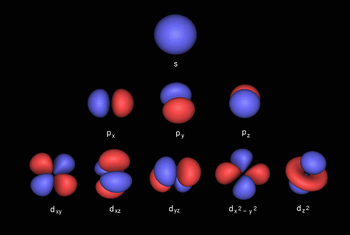Atomic orbital

An Atomic orbital is a mathematical function that describes the wave-like behavior of either one electron or a pair of electrons in an atom. This function can be used to calculate the probability of finding any electron of an atom in any specific region around the atom's nucleus. These functions may serve as three-dimensional graph of an electron’s likely location. The term may thus refer directly to the physical region defined by the function where the electron is likely to be. Specifically, atomic orbitals are the possible quantum states of an individual electron in the collection of electrons around a single atom, as described by the orbital function.
Despite the obvious analogy to planets revolving around the Sun, electrons cannot be described as solid particles and so atomic orbitals rarely, if ever, resemble a planet's elliptical path. A more accurate analogy might be that of a large and often oddly-shaped atmosphere (the electron), distributed around a relatively tiny planet (the atomic nucleus). Atomic orbitals exactly describe the shape of this atmosphere only when a single electron is present in an atom. When more electrons are added to a single atom, the additional electrons tend to more evenly fill in a volume of space around the nucleus so that the resulting collection (sometimes termed the atom’s “electron cloud” ) tends toward a generally spherical zone of probability describing where the atom’s electrons will be found. Electron atomic and molecular orbitals. The chart of orbitals (left) is arranged by increasing energy (see Madelung rule). Note that atomic orbits are functions of three variables (two angles, and the distance from the nucleus, r). These images are faithful to the angular component of the orbital, but not entirely representative of the orbital as a whole.
The idea that electrons might revolve around a compact nucleus with definite angular momentum was convincingly argued in 1913 by Niels Bohr,and the Japanese physicist Hantaro Nagaoka published an orbit-based hypothesis for electronic behavior as early as 1904. However, it was not until 1926 that the solution of the Schrödinger equation for electron-waves in atoms provided the functions for the modern orbitals.
Because of the difference from classical mechanical orbits, the term "orbit" for electrons in atoms, has been replaced with the term orbital—a term first coined by chemist Robert Mulliken in 1932. Atomic orbitals are typically described as “hydrogen-like” (meaning one-electron) wave functions over space, categorized by n, l, and m quantum numbers, which correspond with the pair of electrons' energy, angular momentum, and an angular momentum direction, respectively. Each orbital (defined by a different set of quantum numbers), and which contains a maximum of two electrons, is also known by the classical names used in the electron configurations shown on the right. These classical orbital names (s, p, d, f) are derived from the characteristics of their spectroscopic lines: sharp, principal, diffuse, and fundamental, the rest being named in alphabetical order.
From about 1920, even before the advent of modern quantum mechanics, the aufbau principle (construction principle) that atoms were built up of pairs of electrons, arranged in simple repeating patterns of increasing odd numbers (1,3,5,7..), had been used by Niels Bohr and others to infer the presence of something like atomic orbitals within the total electron configuration of complex atoms. In the mathematics of atomic physics, it is also often convenient to reduce the electron functions of complex systems into combinations of the simpler atomic orbitals. Although each electron in a multi-electron atom is not confined to one of the “one-or-two-electron atomic orbitals” in the idealized picture above, still the electron wave-function may be broken down into combinations which still bear the imprint of atomic orbitals; as though, in some sense, the electron cloud of a many-electron atom is still partly “composed” of atomic orbitals, each containing only one or two electrons. The physicality of this view is best illustrated in the repetitive nature of the chemical and physical behavior of elements which results in the natural ordering known from the 19th century as the periodic table of the elements. In this ordering, the repeating periodicity of 2, 6, 10, and 14 elements in the periodic table corresponds with the total number of electrons which occupy a complete set of s, p, d and f atomic orbitals, respectively.